Top Digital Marketing Tools For Small Businesses | Boost Your Marketing
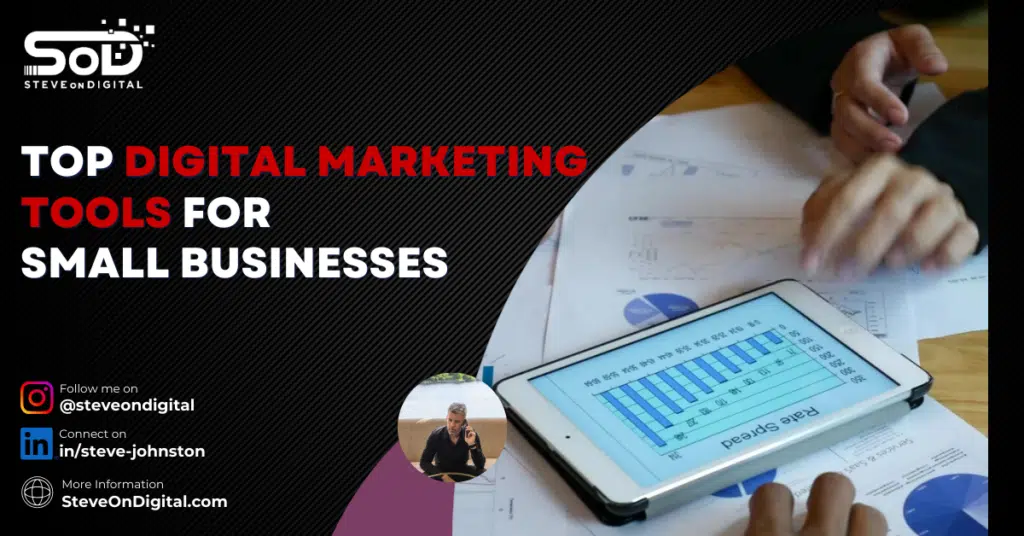
Digital marketing tools for small businesses are essential to help you reach your target audience effectively and grow your online presence. These tools assist in everything from social media management to search engine optimization, making your marketing efforts more efficient and impactful. In my experience, using the right tools can simplify even the most complex tasks, allowing you to focus on what matters most—growing your business. Whether you’re just starting or looking to scale, these tools are designed to maximize your marketing strategies and deliver real results. I’m Steve, a digital transformation expert with a strong background in electrical engineering, an MBA, and a master’s in Project Management. I excel at helping SMEs navigate the digital landscape with practical insights. Let’s begin! Understanding the Basics of Digital Marketing Tools Before diving into the specifics, it’s crucial to understand the basic categories of digital marketing tools. These tools can be broadly divided into several categories, each serving a unique function in your overall marketing strategy. Let me walk you through the essentials. SEO Tools Search Engine Optimization (SEO) tools are the backbone of any digital marketing strategy. These tools help improve your website’s visibility on search engines like Google, ensuring that your small business ranks higher in search results. SEO is all about making your website more attractive to search engines, and the right tools can make this process much easier. Keyword Research Tools Keyword research is the first step in any SEO strategy. It’s about finding the right keywords that your potential customers are searching for. Tools like Google Keyword Planner or SEMrush can help you identify these keywords, giving you insights into what people are looking for. These tools are invaluable for optimizing your content and ensuring that it meets the needs of your audience. Free SEO Tools If you’re just starting, there are plenty of free SEO tools that can give you a solid foundation. Google Search Console, for example, offers insights into how your website is performing in Google search results. Another great tool is Yoast SEO, a plugin for WordPress that helps you optimize your content directly from your website’s backend. These tools are perfect for small businesses with tight budgets, providing powerful features without the cost. Social Media Marketing Tools Social media is where your customers are, so it’s where you need to be too. Social media marketing tools help you manage your presence across multiple platforms, schedule posts, and analyze the performance of your social media campaigns. With these tools, you can streamline your social media efforts and ensure that your brand stays active and engaging. Social Media Management Tools Managing multiple social media accounts can be time-consuming. Platforms like Hootsuite and Buffer enable you to schedule posts, monitor mentions, and analyze your performance across social media channels like Facebook, Twitter, and Instagram. These tools are essential for maintaining a consistent social media presence without spending all your time online. Social Media Campaigns Running a successful social media campaign requires more than just posting regularly. Tools like Sprout Social or Canva help you plan and execute campaigns that resonate with your audience. Whether you’re launching a new product or promoting a sale, these tools provide the resources you need to create compelling social media campaigns that drive results. Email Marketing Tools Email remains one of the most effective marketing channels for small businesses. Email marketing tools help you create, send, and track emails, ensuring that your messages reach your customers and encourage engagement. These tools are particularly valuable for nurturing customer relationships and driving repeat business. Email Marketing Software Software like Mailchimp or Campaign Monitor offers powerful features for creating and managing email campaigns. These platforms allow you to design emails with drag-and-drop editors, segment your audience for targeted messaging, and track the performance of your campaigns. Email marketing software is a must-have for any small business looking to maintain regular contact with its customers. Email Marketing Automation Automation is the key to efficient email marketing. Tools like HubSpot or ActiveCampaign enable you to automate your email marketing tasks, from sending welcome emails to following up on abandoned carts. By automating these processes, you can save time and ensure that your customers receive timely, relevant communications. Essential Analytics Tools for Monitoring Success To measure the effectiveness of your digital marketing efforts, you need analytics tools. These tools provide insights into how your campaigns are performing, helping you make data-driven decisions. Analytics tools are crucial for understanding what’s working and where you need to improve. Google Analytics Google Analytics is the go-to tool for understanding your website’s performance. It provides detailed insights into user behavior, showing you how visitors interact with your site. With Google Analytics, you can track everything from page views to conversion rates, giving you a clear picture of your website’s success. Data Analytics In addition to Google Analytics, other data analytics tools like Hotjar or Crazy Egg offer additional insights into user behavior. These tools allow you to see where users are clicking, how they navigate your site, and where they drop off. By analyzing this data, you can optimize your website to improve the user experience and boost conversions. Project Management Tools Managing your digital marketing projects can be challenging, especially when you’re juggling multiple campaigns. Project management tools help you stay organized, track your progress, and collaborate with your team. These tools are essential for ensuring that your marketing efforts stay on track. Enhancing Customer Relationships with CRM Tools Customer Relationship Management (CRM) tools are designed to help you manage your interactions with customers. These tools allow you to track customer interactions, manage leads, and nurture relationships, ensuring that your customers feel valued and engaged. CRM Tools Tools like Salesforce or Zoho CRM provide comprehensive solutions for managing customer relationships. These platforms allow you to track every interaction with your customers, from initial contact to post-sale follow-up. By using a CRM tool, you can ensure that no customer falls through the cracks. Email Marketing Integration One of the
How Are Small Businesses Using AI To Grow And Compete? | The Ultimate Guide
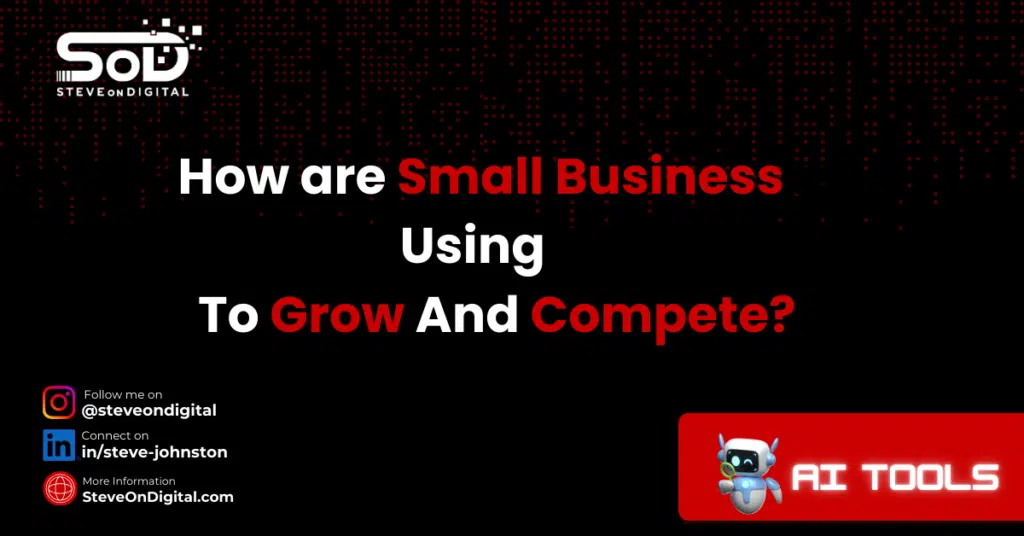
Small businesses are using AI to streamline operations, enhance customer interactions, and drive growth. AI tools help with tasks like managing inventory, personalizing marketing campaigns, and automating customer service, making it easier for small business owners to compete with larger companies. In my own experience, AI has been invaluable for saving time and reducing costs. Whether it’s through data analysis to make informed decisions or using AI-powered tools to optimize daily tasks, AI is transforming how small businesses like mine operate. As more small businesses adopt AI, its impact on efficiency and customer satisfaction continues to grow. I’m Steve, a digital transformation expert with a strong background in electrical engineering, an MBA, and a master’s in Project Management. I excel at helping SMEs navigate the digital landscape with practical insights. Let’s begin! The Role of AI in Transforming Business Operations AI is reshaping the way small businesses operate daily. It’s no longer about manually handling every task; AI is stepping in to take care of the repetitive tasks, allowing me and other small business owners to focus on more strategic aspects of our businesses. Let me share how AI has transformed some key areas of my operations. Streamlining Inventory Management With AI Tools One of the biggest challenges I’ve faced as a small business owner is managing inventory. Before adopting AI tools, it was a constant struggle to predict demand accurately, leading to either overstock or stockouts. But with AI-powered tools, I can now analyze historical data and market trends to predict demand more accurately. For example, AI algorithms can forecast which products will be in demand during specific seasons, helping me optimize my inventory levels and reduce excess stock. This not only saves money but also ensures that I can meet customer demand without delays. Enhancing Employee Productivity Through AI Employee productivity is another area where AI has made a significant impact. In the past, my team spent countless hours on repetitive tasks like data entry, scheduling, and basic customer interactions. With AI, many of these tasks are now automated, freeing up time for my employees to focus on more critical thinking and innovation. For example, AI-driven tools like chatbots can handle basic customer inquiries, while AI-based scheduling software manages appointments and task assignments. This not only boosts productivity but also improves employee satisfaction, as they can now focus on more engaging and meaningful work. Incorporating AI in Scheduling and Task Management Effective time management is crucial for any small business, and AI has been a lifesaver in this regard. I’ve incorporated AI tools that assist in scheduling tasks and managing time more efficiently. These tools analyze my daily operations and suggest optimal times for meetings, task assignments, and even breaks. This level of efficiency was hard to achieve manually, but with AI, I can ensure that every minute of my day—and my team’s day—is used wisely. AI-Driven Marketing Strategies for Small Businesses Marketing has always been a challenge for small businesses, especially with limited budgets. However, AI is revolutionizing how we approach marketing, making it possible to compete with larger companies by leveraging data and automation. Personalizing Marketing Campaigns With AI One of the most significant benefits of AI in marketing is personalization. AI tools enable me to create marketing campaigns tailored to individual customer preferences, based on their behavior and purchasing history. For example, AI can analyze customer data to identify patterns and trends, allowing me to send personalized emails or product recommendations that resonate with my customers. This level of personalization was once only achievable by large companies with access to extensive resources, but now, AI has leveled the playing field. Leveraging AI for Social Media Management Social media is a powerful tool for engaging with customers, but managing multiple platforms can be overwhelming. AI has helped me streamline my social media efforts by automating tasks such as scheduling posts and analyzing customer sentiment. With AI, I can schedule posts at optimal times to reach my target audience and analyze the performance of each post to understand what resonates with my followers. This data-driven approach ensures that my social media efforts are not just a shot in the dark but are based on actual customer insights. AI in Content Generation and Product Descriptions Content creation is another area where AI has proven invaluable. AI-powered tools can generate content, including product descriptions and marketing copy, that is engaging and optimized for search engines. I’ve used AI to create product descriptions that highlight key features and benefits, making them more appealing to potential customers. This not only saves time but also ensures that my content is consistent and aligned with my brand’s voice. Enhancing Customer Experiences With AI Customer experience is at the heart of any successful business, and AI is helping small businesses like mine deliver better, more personalized experiences. AI-Powered Customer Relationship Management (CRM) Systems CRM systems powered by AI have become indispensable for managing customer relationships. These systems provide valuable insights into customer behavior and preferences, allowing me to tailor my interactions and offers to meet their needs. For example, AI can analyze customer data to identify trends, such as which products are popular among certain customer segments, enabling me to create targeted promotions that drive sales. Automating Customer Interactions With AI Chatbots AI chatbots have transformed the way I handle customer interactions. These chatbots can manage more complex customer interactions, providing quick and accurate responses to inquiries. This enhances the customer experience while also allowing my team to concentrate on more essential tasks. For instance, if a customer needs help with an order, the chatbot can handle the initial inquiry, while more complex issues are escalated to a human representative. Sentiment Analysis for Improved Customer Insights Understanding customer sentiment is crucial for improving products and services. AI tools that perform sentiment analysis have allowed me to gain deeper insights into how customers feel about my offerings. By analyzing customer feedback, reviews, and social media comments, I can identify areas for improvement and address
How AI Will Revolutionize Small Business In The Future | SOD
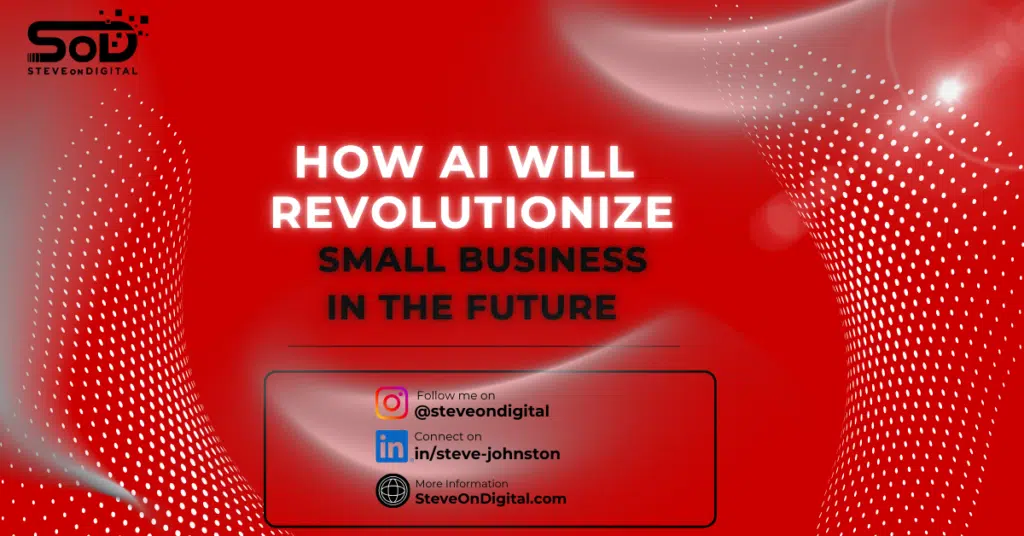
AI will revolutionize small businesses by automating tasks, enhancing customer service, and driving data-driven decisions. It allows small businesses to streamline operations, improve efficiency, and gain a competitive edge in a rapidly evolving market. As AI technology continues to advance, it’s becoming an essential tool for business owners to stay competitive and succeed. Artificial Intelligence is no longer just for big corporations. I’ve seen firsthand how AI tools can transform small businesses by optimizing marketing strategies, improving customer engagement, and providing insights that were once out of reach. This blog explores how embracing AI can drive future success for small businesses. I’m Steve, a digital transformation expert with a strong background in electrical engineering, an MBA, and a master’s in Project Management. I excel at helping SMEs navigate the digital landscape with practical insights. Let’s begin! The Evolution of AI Technology AI technology has come a long way, from simple automation tools to sophisticated systems that can learn and adapt. The rapid growth and development of AI mean that what was once only accessible to large corporations is now within reach for small businesses. This section dives into how AI technology has evolved and why it’s more relevant than ever for small businesses to integrate these advancements into their operations. AI Technology Continues to Advance AI is constantly evolving, with new developments in machine learning and natural language processing. These advancements have significant implications for small businesses. For instance, AI can now handle complex tasks that require understanding and responding to human language, like customer inquiries. This means small businesses can provide 24/7 customer support without the need for a large team. Moreover, AI’s ability to learn from data means it can continually improve its performance, making it an invaluable tool for any small business looking to stay competitive. AI Innovations in Multiple Industries AI is not just for tech companies; it’s being adopted across multiple industries, from retail to healthcare. These innovations can be adapted for small business operations, helping to improve efficiency and reduce costs. For example, AI-driven inventory management systems are helping small retailers optimize stock levels, reducing waste, and ensuring that they always have the right products available for their customers. In healthcare, small practices are using AI to streamline patient scheduling and automate routine tasks, freeing up time for more critical activities. AI Tools and Solutions for Small Businesses The AI tools available today are powerful and accessible, designed to help small businesses enhance efficiency, improve customer service, and gain a competitive edge. I’ve explored and implemented several of these tools in my own business, and the results have been nothing short of transformative. This section provides an in-depth look at the AI tools and solutions that small businesses can use to stay ahead of the curve. AI-Driven Solutions AI-driven solutions are designed to streamline operations and improve decision-making processes. For instance, AI algorithms can sift through extensive customer data to uncover trends and patterns that might not be immediately noticeable. This data-driven decision-making process allows small businesses to make informed choices that can significantly impact their bottom line. Additionally, AI can help small businesses automate routine tasks, such as processing orders or managing customer inquiries, freeing up time for more strategic activities. Automating Routine Tasks One of the most significant advantages of AI is its ability to automate routine tasks. For small business owners like me, time is always in short supply. Automating tasks like data entry, invoicing, or even social media management can save countless hours each week. AI tools can handle these tasks efficiently and accurately, reducing the risk of human error and allowing you to focus on growing your business. AI-Based Systems for Small Businesses AI-based systems are specifically designed for small businesses to optimize their operations. These systems can range from customer relationship management (CRM) tools that help you manage customer interactions to AI-powered chatbots that provide instant customer support. By integrating these systems into your business, you can improve efficiency, enhance customer service, and ultimately increase your profitability. Leveraging AI for Customer Experience Enhancement Customer experience is at the heart of any successful business, and AI has the potential to revolutionize how small businesses interact with their customers. From personalizing marketing messages to providing instant support, AI can help you enhance your customer experience in ways that were previously unimaginable. Enhancing Customer Service with AI Customer service is one area where AI truly shines. With AI tools, small businesses can provide quick, accurate responses to customer inquiries, no matter the time of day. For example, AI-powered chatbots can handle common customer questions, such as product availability or order status, freeing up your team to focus on more complex issues. In my experience, implementing AI in customer service has not only improved customer satisfaction but also reduced the workload for my team. Personalized Customer Experience AI can also help small businesses provide a more personalized customer experience. By analyzing customer data, AI tools can identify individual preferences and behaviors, allowing you to tailor your marketing messages and product recommendations to each customer. This level of personalization can lead to higher customer satisfaction and increased loyalty, which are crucial for the long-term success of any small business. AI in Marketing Strategies Artificial intelligence (AI) is changing the way small businesses approach marketing. With the power to analyze vast amounts of data, AI helps small businesses create more personalized, effective marketing strategies. Over the years, I’ve learned that the success of a marketing campaign often hinges on understanding your audience and delivering the right message at the right time. AI makes this possible by offering tools that can predict customer behavior and segment audiences more precisely than ever before. Personalized Marketing with AI One of the most significant advantages of AI in marketing is its ability to deliver personalized messages to different customer segments. AI tools can analyze customer data, such as purchase history and browsing behavior, to create highly targeted marketing campaigns. For example, I’ve seen small businesses use AI
Difference Between Digital Transformation And Business Transformation: A Clear Guide
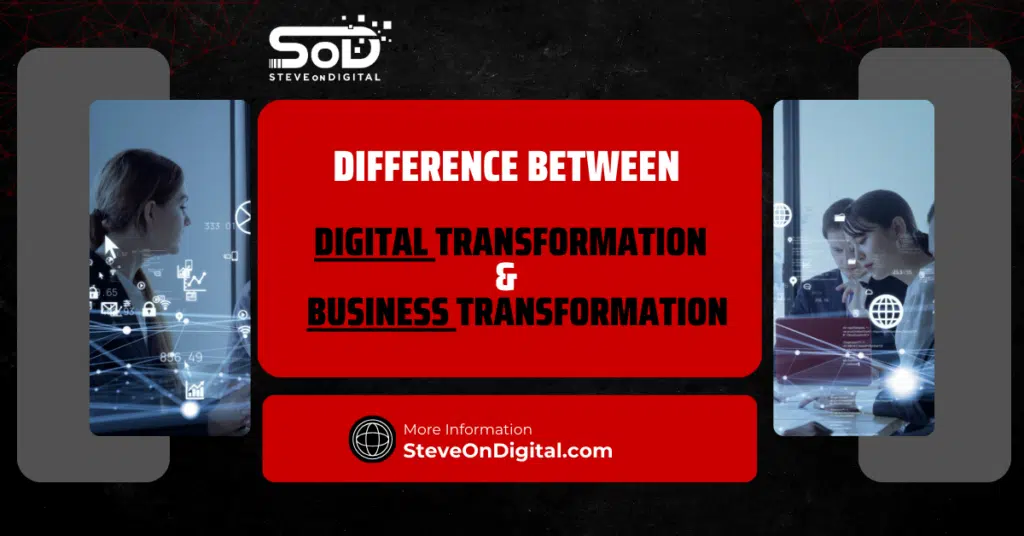
Digital transformation involves integrating digital technologies into every part of a business to improve operations and customer experiences. Business transformation is broader, focusing on changing business models, processes, and culture to enhance overall performance. Understanding these differences is crucial. While digital transformation often focuses on technology, business transformation includes everything from strategy to operations. In this article, I’ll break down both concepts, sharing insights from my experience to help you determine which approach suits your business needs. I’m Steve, a digital transformation expert with a strong background in electrical engineering, an MBA, and a master’s in Project Management. I excel at helping SMEs navigate the digital landscape with practical insights. Let’s begin! Understanding Digital Transformation Digital transformation has become a buzzword, but what does it really mean? Let’s dive into the specifics and explore how it reshapes businesses. Definition Of Digital Transformation Digital business transformation involves integrating digital technologies across all facets of a business, fundamentally altering operations and enhancing the value delivered to customers. It’s not just about adopting new technology—it’s about using that technology to improve every facet of your business, from operations to customer experience. Key Drivers Of Digital Transformation Several factors drive the need for digital transformation. The rapid pace of technological advancements is a significant driver, forcing businesses to adapt or risk falling behind. Customer demands also play a crucial role, as today’s customers expect seamless digital experiences. Finally, competitive pressures push businesses to innovate continuously to stay ahead. Role Of Digital Technologies In Business Digital technologies are at the core of digital transformation. Technologies such as cloud computing, artificial intelligence, and machine learning enable businesses to automate processes, gain insights from data analytics, and enhance customer experiences. For instance, cloud computing offers scalability and flexibility, allowing businesses to adapt quickly to changing market dynamics. Exploring Business Transformation While digital transformation focuses on technology, business transformation is broader and encompasses changes to business models, processes, and culture. Definition Of Business Transformation Business transformation involves a fundamental change in how a company operates, with the goal of improving performance. This transformation can include changes to business models, organizational structures, and business processes. It’s about rethinking how your entire organization functions to improve efficiency, meet new challenges, and drive growth. Key Drivers Of Business Transformation Business transformation is driven by the need to adapt to evolving market dynamics, customer preferences, and operational inefficiencies. For example, changes in market conditions, such as increased competition or shifts in consumer behavior, can necessitate a transformation in how a business operates. Role Of Business Strategies In Transformation Strategic planning is vital for successful business transformation. Business leaders must develop and execute strategies that align with the organization’s goals, taking into account the internal and external factors driving the need for change. Leadership plays a critical role in guiding the transformation process, ensuring that changes are implemented effectively and sustainably. Key Differences Between Digital Transformation And Business Transformation Understanding the key differences between these two types of transformation is essential for selecting the right approach for your business. Scope And Focus Digital transformation is primarily focused on integrating digital technologies into existing processes to improve efficiency and customer experience. In contrast, business transformation has a broader scope, encompassing changes to the entire business model, processes, and organizational culture. While digital transformation may be part of a business transformation, the latter is more comprehensive and strategic. Technological Integration Digital transformation revolves around the adoption and integration of digital technologies like cloud computing and AI. Business transformation, on the other hand, may include technological integration but also addresses changes in business strategies, processes, and culture. It’s about ensuring that the entire organization is aligned and optimized to achieve its goals. Impact On Business Models Both digital and business transformations can significantly impact a company’s business model. Digital transformation may lead to new digital business models or enhancements to existing ones, while business transformation might involve a complete overhaul of how the company operates. For example, a company might shift from a product-based model to a service-based model as part of its business transformation. The Intersection Of Digital And Business Transformation In my experience, the intersection of digital transformation and business transformation is where the magic truly happens. These two concepts, while distinct, often converge in ways that can redefine how a company operates. I’ve seen firsthand how the integration of digital strategies within broader business transformation efforts can create a powerful synergy, leading to sustainable growth and innovation. Digital Transformation As A Subset Of Business Transformation Digital transformation is more than just adopting new technologies—it’s about embedding these digital technologies within the broader context of business transformation. When I work with businesses, I emphasize that digital transformation should not be seen as a standalone initiative but as a critical component of overall business transformation. This approach allows for a more holistic change that impacts every aspect of the business, from customer experience to internal processes. Leveraging Digital Tools For Business Transformation Digital tools are essential in facilitating business transformation. Tools like data analytics, cloud computing, and machine learning enable businesses to optimize processes, improve efficiency, and better meet customer demands. For example, I once worked with a small business that used data analytics to transform its customer engagement strategy, leading to a significant increase in customer satisfaction and loyalty. Leveraging these tools effectively can be a game-changer for any business looking to stay competitive in today’s digital landscape. Case Studies Of Successful Integration Real-world examples often provide the best learning experiences. I’ve seen numerous businesses successfully integrate digital and business transformation strategies, leading to impressive results. Take the case of a retail company I advised, which integrated robotic process automation (RPA) into its supply chain management as part of a larger business transformation. This move not only reduced operational costs but also improved supply chain efficiency, leading to a 20% increase in on-time deliveries. Digital Transformation Strategies Developing a clear and actionable digital transformation strategy is crucial. Without a well-thought-out plan, digital transformation
Why Data Analysis Is Crucial For Small Businesses: Ultimate Guide

Small businesses need data analysis to make better decisions, optimize operations, and drive growth. By analyzing data, I can uncover valuable insights that help me understand customer preferences, improve marketing strategies, and enhance overall efficiency. In today’s competitive market, relying on gut feeling isn’t enough. Data analysis provides the hard facts needed to stay ahead. Whether it’s tracking sales trends, managing inventory, or refining customer service, data analysis is essential for making informed decisions that lead to success. I’m Steve, a digital transformation expert with a strong background in electrical engineering, an MBA, and a master’s in Project Management. I excel at helping SMEs navigate the digital landscape with practical insights. Let’s begin! Understanding Data Analysis To get the most out of data analysis, it’s crucial to understand what it entails. Data analysis is more than just collecting data; it’s about making sense of that data to inform your decisions. Whether you’re tracking customer behavior, sales trends, or market shifts, data analysis can give you the actionable insights you need to stay competitive. What Is Data Analysis? At its core, data analysis is the process of inspecting, cleaning, and modeling data to discover useful information. This process involves looking at both structured data—like sales numbers and customer feedback—and unstructured data, such as social media comments or customer emails. Structured data is typically easier to analyze because it’s organized in tables or databases. Unstructured data, however, can be more challenging but often contains rich insights. Difference Between Data Analysis And Data Analytics While these terms are often used interchangeably, they are not exactly the same. Data analysis refers to the process of analyzing data to extract insights, while data analytics is broader and includes the tools and processes used to perform that analysis. Data analytics often involves the use of specialized software to automate data collection, storage, and processing, allowing for more complex analysis. Key Data Analysis Techniques Several techniques can help you extract the most valuable insights from your data. Descriptive analysis is the simplest form, summarizing past data to understand what has happened. Diagnostic analysis goes a step further by examining why something happened. Predictive analysis uses historical data to forecast future outcomes, while prescriptive analysis suggests actions you can take to influence those outcomes. Each of these techniques plays a crucial role in helping small businesses make data-driven decisions. The Role Of Data Analysis In Small Businesses Now that we understand what data analysis is, let’s explore why it’s so important for small businesses. For a small business, staying competitive often means doing more with less. Data analysis allows you to do just that by providing insights that can improve every aspect of your business. Enhancing Operational Efficiency One of the most significant benefits of data analysis is its ability to enhance operational efficiency. By analyzing data from your operations, you can identify bottlenecks, streamline processes, and allocate resources more effectively. For instance, by analyzing sales data, I’ve been able to identify which products are best-sellers and adjust inventory levels accordingly, reducing waste and improving cash flow. Improving Customer Experience Customer data analysis is a game-changer for understanding what your customers want and need. By analyzing customer feedback and behavior, you can tailor your offerings to better meet their expectations, resulting in higher satisfaction and loyalty. I’ve found that regularly analyzing customer feedback has allowed me to refine my services and offer more personalized experiences, which has been key to retaining customers. Driving Marketing Efforts Marketing can be a significant expense for small businesses, so it’s essential to ensure your efforts are as effective as possible. Data analysis allows you to track the performance of your marketing campaigns, understand what works, and adjust your strategies accordingly. For example, using Google Analytics to analyze website traffic has provided me with valuable insights into which marketing channels are driving the most conversions, allowing me to focus my efforts where they matter most. Collecting And Managing Data For Small Businesses Collecting and managing data is the foundation of any effective data analysis strategy. Without accurate and comprehensive data, your analysis will be flawed, leading to poor decision-making. Here’s how small businesses can effectively collect and manage their data. Data Collection Methods There are various ways to collect data, depending on your business type and goals. For instance, you can collect customer data through surveys, purchase histories, or social media interactions. For my business, I use a mix of online surveys and website analytics to gather data on customer preferences and behavior. The key is to collect data consistently and from multiple sources to get a well-rounded view. Data Storage Solutions Once you’ve collected your data, it’s essential to store it securely and efficiently. Cloud storage solutions like Google Drive or more sophisticated platforms like AWS offer small businesses the flexibility to store large amounts of data without significant upfront costs. I’ve found cloud storage to be particularly useful because it’s scalable, meaning I can increase storage as my data needs grow without investing in expensive hardware. Managing Raw And Structured Data Managing data involves more than just storage; it’s also about organizing and cleaning your data to ensure accuracy. Raw data often needs to be processed and converted into structured formats before it can be effectively analyzed. I use data management tools that help me clean and organize my data, making it easier to analyze and extract actionable insights. Whether you’re dealing with raw sales data or structured customer feedback, having the right tools and processes in place is critical to effective data management. Utilizing Data Analytics Tools Data analysis is only as good as the tools you use to perform it. In the fast-paced world of small business, having the right tools at your disposal can make all the difference between drowning in data and turning that data into actionable insights. Over the years, I’ve found that using the right data analytics tools not only saves time but also provides the clarity needed to make informed decisions. Popular Data
Best Ways To Market Small Business: Top Strategies | SOD

To effectively market a small business, start by understanding your target audience and creating a solid marketing strategy. Use social media, content marketing, and paid ads to reach potential customers and boost brand awareness. Effective marketing is vital for small businesses to thrive and grow. Reaching potential customers and retaining existing ones can make or break your business. A comprehensive small business marketing strategy is essential for building brand awareness, increasing sales, and achieving long-term success. I’m Steve, a digital transformation expert with a strong background in electrical engineering, an MBA, and a master’s in Project Management. I excel at helping SMEs navigate the digital landscape with practical insights. Let’s begin! Understanding Your Target Audience Knowing your target audience is the foundation of any successful marketing strategy. When you know who your potential customers are, you can adjust your marketing efforts to match their needs and preferences. Defining Your Target Market Determining your target market involves identifying the specific group of people who are most likely to buy your products or services. Consider factors like age, gender, income, location, and interests. By narrowing down your target market, you can focus your resources on those most likely to become paying customers. Market Research Techniques Conducting market research is crucial for gathering insights about your potential customers. Use surveys, interviews, and focus groups to collect data. Analyzing your competitors can also provide valuable information about what works and what doesn’t in your industry. Creating Customer Personas Customer personas are detailed profiles that represent different segments of your target audience. They help you visualize and understand your customers’ needs, behaviors, and motivations. When creating personas, include demographic details, pain points, and buying habits. This personalized approach can guide your marketing messages and improve engagement. Crafting a Small Business Marketing Strategy A well-rounded marketing strategy encompasses various elements tailored to your business needs and goals. Setting Marketing Goals Clear, achievable marketing goals provide direction and a way to measure success. Goals can include growing website traffic, acquiring new leads, or enhancing social media engagement. Make sure your goals are Specific, Measurable, Achievable, Relevant, and Time-bound (SMART). Goal Specific Measurable Achievable Relevant Time-bound Increase Website Traffic Increase monthly visitors By 20% (from 1,000 to 1,200) Yes Aligns with growth strategy Within 3 months Generate Leads Acquire new leads 50 new leads per month Yes Supports sales team Within 6 months Boost Social Media Engagement Increase post engagement By 30% (likes, shares, comments) Yes Enhances online presence Within 2 months Developing a Marketing Plan A comprehensive marketing plan outlines the strategies and tactics you’ll use to reach your marketing goals. It should include details on your target audience, marketing channels, and content strategy. Planning ahead ensures you stay organized and focused on your objectives. Budgeting for Marketing Efforts Allocating a budget effectively is crucial for maximizing your marketing efforts. Determine how much you can spend on different marketing initiatives, such as advertising, content creation, and social media management. Prioritize spending based on what delivers the best return on investment (ROI). Building a Strong Online Presence A robust online presence is essential for reaching a wider audience and establishing credibility. Here are the steps to achieve it. Creating a Professional-Looking Website Your website is often the first impression potential customers have of your business. Ensure it is professional, user-friendly, and mobile-responsive. Include clear calls-to-action (CTAs), contact information, and an easy-to-navigate layout. High-quality images and relevant content can enhance user experience and encourage visitors to stay longer. Search Engine Optimization (SEO) Search engine optimization (SEO) is the practice of improving your website to achieve higher rankings in search engine results. Start with keyword research to identify the terms your target audience is searching for. Incorporate these keywords naturally into your website content, meta descriptions, and headers. Additionally, focus on technical SEO aspects like page speed, mobile optimization, and secure connections (HTTPS). Managing Your Google Business Profile A Google Business Profile is essential for local visibility. It helps your business appear in local search results and Google Maps. Make sure your profile includes accurate business information such as address, phone number, and hours of operation. Encourage satisfied customers to leave reviews, as positive feedback can enhance your reputation and attract more customers. Leveraging Social Media Platforms Social media platforms are indispensable for small business marketing. They offer an affordable and effective way to connect with potential customers and build a loyal customer base. I’ve seen firsthand how social media can transform a small business’s reach and engagement. Choosing the Right Social Media Channels Selecting the right social media platforms for your business is crucial. Different platforms attract different audiences. For instance, Facebook is great for reaching a broad audience, while Instagram is perfect for visual content and younger demographics. LinkedIn works best for B2B marketing. Start by identifying where your target audience spends most of their time online. Platform Best For Audience Content Type Facebook Broad audience, local targeting Adults 25-55 Posts, ads, events, videos Instagram Visual content, younger demographics Teens to adults 18-35 Photos, stories, reels, ads LinkedIn B2B marketing, professional networking Professionals, businesses Articles, job postings, networking Twitter Real-time updates, news Adults 18-49 Tweets, news updates, promotions Creating Engaging Social Media Content Creating engaging content is essential for keeping your social media presence active and interactive. Share a mix of content types, including images, videos, articles, and polls. My experience shows that authentic, behind-the-scenes content often gets the most engagement. Be consistent with your posting schedule and always interact with your audience by responding to comments and messages. Utilizing Social Media Advertising Running effective social media ad campaigns can significantly increase your reach. Platforms like Facebook and Instagram offer highly targeted advertising options. You can target ads based on demographics, interests, and behavior. I recommend starting with a small budget and testing different ad creatives to see what resonates with your audience. Always track your ad performance and adjust your strategies accordingly. Content Marketing Strategies Content marketing involves producing valuable and relevant content to attract and
ChatGPT For Small Businesses | The Ultimate Guide

ChatGPT, created by OpenAI, is a sophisticated AI model that leverages Natural Language Processing (NLP) to comprehend and produce text that mimics human language. It helps small businesses by automating tasks, reducing costs, and improving customer service. As a small business owner, I’ve found ChatGPT invaluable for creating content, managing customer interactions, and analyzing data. This article explores how ChatGPT can benefit small businesses, from enhancing marketing efforts to streamlining operations and improving customer satisfaction. I’m Steve, a digital transformation expert with a strong background in electrical engineering, an MBA, and a master’s in Project Management. I excel at helping SMEs navigate the digital landscape with practical insights. Let’s begin! Understanding ChatGPT What is ChatGPT? ChatGPT is an advanced AI system created by OpenAI that uses Natural Language Processing (NLP) to interpret and generate text similar to human conversation. It’s built on the GPT-4 architecture, making it incredibly powerful for a range of applications, from answering customer inquiries to generating content. How ChatGPT Works At its core, ChatGPT processes language through a complex neural network that predicts and generates text based on the input it receives. It uses a vast dataset to understand context and provide relevant, coherent responses, making it an invaluable tool for automating various tasks. Benefits of ChatGPT for Small Businesses Benefit Description Cost Efficiency Reduces operational costs by automating tasks. Customer Service Enhances customer interaction and satisfaction with instant responses. Streamlined Operations Automates repetitive tasks, allowing focus on strategic activities. Cost Efficiency One of the primary benefits of ChatGPT is its ability to reduce operational costs. According to a survey, 48% of businesses using ChatGPT have saved more than $75,000 annually. By automating tasks like customer service and content creation, small businesses can significantly cut down on labor costs and increase efficiency. Improving Customer Service ChatGPT can enhance customer interaction and satisfaction by providing instant, accurate responses to customer inquiries. It’s estimated that 57% of businesses use ChatGPT for customer support, improving response times and customer satisfaction rates. Streamlining Operations By automating repetitive tasks, ChatGPT frees up valuable time for you and your team to focus on more strategic activities. This includes everything from scheduling appointments to managing emails, allowing for smoother, more efficient operations. Integrating ChatGPT into Your Business Getting Started with ChatGPT Implementing ChatGPT in your business is straightforward. Start by identifying the key areas where automation can have the most impact, such as customer service or marketing. From there, you can choose a chatbot platform that integrates seamlessly with ChatGPT. Choosing the Right Chatbot Platform There are several popular chatbot platforms compatible with ChatGPT, including ManyChat and MobileMonkey. These platforms offer various features that can be tailored to your specific business needs, from simple Q&A bots to more complex, interactive chatbots. Customization and Fine-Tuning To get the most out of ChatGPT, it’s crucial to customize and fine-tune it to suit your business needs. This might involve training the model with specific data relevant to your industry or adjusting the settings to better handle complex customer queries. Relevant Data and Statistics By integrating ChatGPT into your business, you can harness the power of AI to streamline operations, enhance customer service, and reduce costs, making it a smart investment for any small business owner. ChatGPT for Marketing Strategies Enhancing Marketing Efforts Using ChatGPT for marketing can significantly boost your efforts in creating engaging content and reaching your target audience. One effective use is for social media posts. ChatGPT can generate creative, relevant, and timely posts across various social media platforms. For example, I’ve used ChatGPT to schedule and create posts that keep my followers engaged without the hassle of manual updates. Moreover, ChatGPT helps in crafting marketing materials. Whether it’s an eye-catching slogan or an informative brochure, ChatGPT can produce content that aligns with your brand voice, saving you time and ensuring consistency. Statistics support the efficiency of AI in marketing. A survey showed that 55% of marketing professionals in the US use ChatGPT for content creation (Enterprise Apps Today). This widespread adoption highlights its effectiveness and reliability. Content Creation Generating high-quality content is crucial for any marketing strategy. ChatGPT excels in this area by producing blog posts, product descriptions, and other content types quickly and efficiently. From my personal experience, I’ve seen a notable increase in content output without compromising quality. ChatGPT’s ability to produce content in various tones and styles makes it ideal for different purposes. For instance, I use it to draft blog articles, which helps maintain a steady flow of fresh content on my website. This not only engages my audience but also improves my site’s SEO ranking. Keyword Research and SEO Effective keyword research is the backbone of any SEO strategy. ChatGPT can analyze data to identify the best keywords for your content. By integrating ChatGPT into your SEO processes, you can uncover high-ranking keywords that drive traffic to your website. I’ve utilized ChatGPT to enhance my SEO efforts by generating keyword lists and optimizing content accordingly. The results speak for themselves: increased organic traffic and better search engine rankings. Sales and Lead Generation Lead Generation Techniques ChatGPT can significantly improve lead generation by interacting with potential customers on your website. It can answer queries, provide information, and guide visitors through the sales funnel, effectively turning them into leads. In my experience, implementing ChatGPT on my website has led to a noticeable increase in leads. The AI engages visitors in meaningful conversations, which helps capture their interest and contact information. Personalized Customer Interactions Providing personalized responses to customer inquiries is crucial for building strong customer relationships. ChatGPT can deliver tailored responses based on customer data, making interactions more relevant and engaging. For example, I’ve set up ChatGPT to handle customer service queries, ensuring that each response is customized to the individual’s needs. This personalized approach has improved customer satisfaction and loyalty. Follow-Up Automation Automating follow-up communications is another area where ChatGPT excels. It can send timely follow-up emails or messages, keeping your leads engaged and moving them closer to
Create A Successful Digital Transformation Strategy | Key Steps And Tips
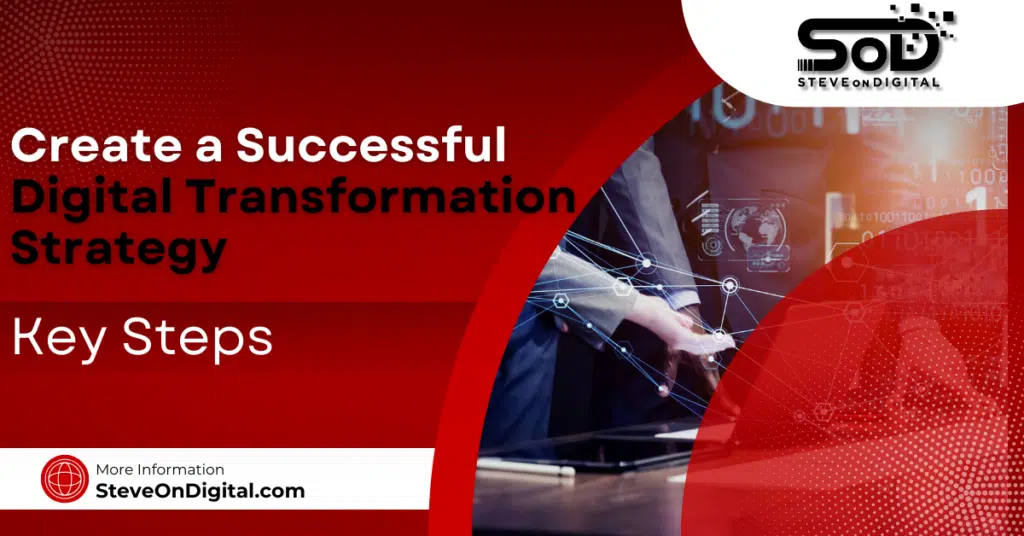
To create a successful digital transformation strategy, evaluate your current business processes and technologies. Establish specific, measurable goals that align with your overall business objectives. Develop a clear roadmap that outlines steps and phases for implementation, ensuring you allocate the necessary resources like budget, technology, and personnel. Regularly track progress with realistic timelines and milestones. Digital transformation is essential for staying competitive in today’s market. According to Flexera, 74% of organizations prioritize digital transformation, and COVID-19 has accelerated these initiatives for 97% of companies. By carefully planning and executing your strategy, you can significantly enhance operational efficiency, and customer satisfaction, and drive revenue growth. I’m Steve, a digital transformation expert with a strong background in electrical engineering, an MBA, and a master’s in Project Management. I excel at helping SMEs navigate the digital landscape with practical insights. Let’s begin! Understanding Digital Transformation Digital transformation involves integrating digital technology into all areas of a business, fundamentally changing how you operate and deliver value to customers. It’s about using digital tools to solve traditional problems and improving business processes to enhance efficiency and customer satisfaction. Importance of Digital Transformation According to a study by Flexera, 74% of organizations consider digital transformation a top priority, showing a significant increase from previous years (Exploding Topics). The COVID-19 pandemic accelerated these initiatives, with 97% of companies stating it sped up their digital transformation by an average of six years (Exploding Topics). This shift highlights the urgent need for businesses to adapt to the digital age. Key Elements of a Digital Transformation Strategy Creating a successful digital transformation strategy involves several critical components. Here’s a comprehensive look at what you need to consider: Key Element Description Assess Current State Evaluate existing business processes and technologies to identify improvement areas. Set Clear Goals Establish specific, measurable goals that align with business objectives. Align with Objectives Ensure the strategy supports overall business goals. Develop a Roadmap Create a step-by-step plan for implementation. Allocate Resources Identify necessary resources including budget, technology, and personnel. Track Progress Set realistic timelines and milestones for tracking progress. Assessing Current Business State Before embarking on any transformation, it’s crucial to evaluate your existing business processes and technologies. This step helps identify areas that need improvement and opportunities for digital integration. For instance, upgrading obsolete IT infrastructure is a top reason for increased IT budgets in 56% of organizations (DOIT). Setting Clear Goals Establishing specific, measurable goals for your digital transformation efforts is essential. These goals should align with your overall business objectives. According to McKinsey, firms with advanced digital maturity report a 45% revenue growth, compared to 15% for lower maturity firms (Whatfix). This statistic underscores the importance of setting clear, achievable goals. Aligning with Business Objectives Your digital transformation strategy should support and enhance your business goals. Whether it’s improving operational efficiency, enhancing customer experience, or driving revenue growth, aligning your strategy with these objectives ensures that digital transformation efforts contribute to the overall success of your business. Developing a Roadmap A clear roadmap is vital for achieving your digital transformation goals. This roadmap should outline the steps and phases of the transformation process, ensuring a structured and manageable approach. Phased Implementation Plan Breaking down your strategy into manageable phases makes execution easier and more organized. For example, companies that have phased their digital transformation efforts reported better management of resources and clearer progress tracking (Outsource Accelerator). Resource Allocation Identify and allocate the necessary resources, including budget, technology, and personnel. According to a report by SWZD, 45% of companies are investing in new IT projects, and 36% are supporting remote workforces (Outsource Accelerator). Proper resource allocation is crucial for the smooth execution of your strategy. Timeline and Milestones Setting realistic timelines and milestones helps track progress and maintain momentum. This approach ensures that each phase of the transformation is completed on schedule, contributing to the overall success of the initiative. Choosing the Right Technologies Selecting the right digital tools and technologies is critical for a successful digital transformation strategy. The choices you make here can significantly impact your organization’s efficiency, customer satisfaction, and overall success. Evaluating Digital Tools When evaluating digital tools, consider the following criteria: Integrating Existing Technologies Integration can be challenging but is crucial for a seamless digital transformation process. Here’s how you can do it effectively: Future-Proofing Technology Investments To ensure long-term value from your technology investments: Enhancing Customer and Employee Experiences Improving the experiences of both customers and employees is a key aspect of a successful digital transformation strategy. Customer Experience Improvement Enhancing customer interactions and satisfaction involves: Strategy Description Personalization Use data analytics to tailor customer experiences. Omnichannel Support Provide consistent service across all channels. Feedback Mechanisms Implement systems to gather and act on customer insights. Employee Experience Enhancement Boosting employee engagement and productivity can be achieved through: Leveraging Customer Feedback Using customer feedback effectively can drive innovation and improvement: Building a Digital Culture Creating a culture that embraces digital transformation and continuous improvement is vital for long-term success. Encouraging Innovation Fostering a culture of innovation involves: Training and Development Investing in employee training to develop digital skills is crucial: Leadership and Vision Effective leadership plays a key role in guiding digital transformation: Monitoring and Measuring Success To ensure the success of your digital transformation initiatives, it’s important to monitor and measure progress regularly. Key Performance Indicators Define and track KPIs to measure the effectiveness of your digital transformation efforts: Continuous Improvement Implement a continuous improvement process to refine strategies and achieve better results: Data-Driven Decisions Use data analysis to inform and adjust your strategies: Managing Change Effectively Managing change is crucial for a successful digital transformation. Change management addresses the challenges that come with implementing new technologies and processes. Here’s how to handle it effectively. Communication Strategies Effective communication is key to managing change. Here’s what I focus on: Stakeholder Engagement Engaging stakeholders is essential for gaining buy-in and support. Here are some strategies I use: Overcoming Resistance Resistance to change is natural. Here’s how I
Document Management System | Everything You Need To Know!
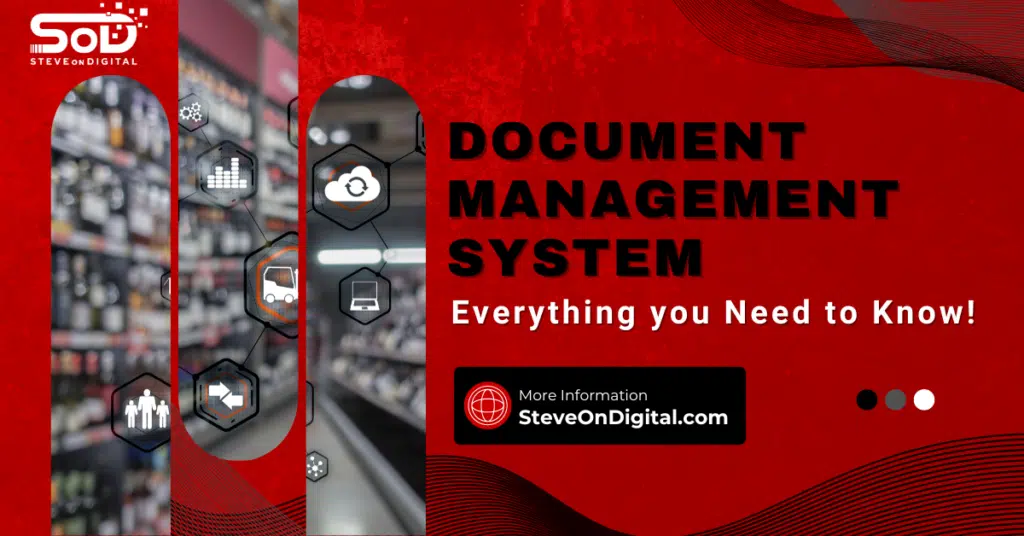
A Document Management System (DMS) is a software solution that helps businesses manage, store, and track electronic documents. Selecting the best document management system is crucial for ensuring integration capabilities, data security, scalability, document search capabilities, mobile access, and cost comparison. By digitizing document handling processes, a DMS reduces reliance on physical storage and improves accessibility across the organization. Document Management Systems (DMS) have become essential for modern businesses, enabling efficient handling, storage, and retrieval of electronic documents. Transitioning from traditional paper-based systems to advanced electronic solutions enhances productivity and ensures data security. I’m Steve, a digital transformation expert with a strong background in electrical engineering, an MBA, and a master’s in Project Management. I excel at helping SMEs navigate the digital landscape with practical insights. Let’s begin! What Is A Document Management System? Definition of Document Management System A Document Management System (DMS) is a comprehensive document management solution that includes document life cycle control, metadata, access control, and integration with other business solutions. By digitizing document handling processes, a DMS reduces the reliance on physical storage and improves information accessibility across the organization. History of Document Management Systems The evolution of document management began with filing cabinets in the late 1800s. The advent of computers in the 1980s marked the beginning of electronic document management, which further evolved with the introduction of scanners and personal computers. Today, cloud-based DMS solutions dominate the market, offering enhanced flexibility and accessibility (TinyMCE) (Axero Solutions). Types of Document Management Systems There are three main types of DMS: Type of DMS Description Advantages Cloud-Based Stores documents on remote servers, accessible via internet. Flexible access, reduced IT costs, easy scalability. On-Premises Installed on local servers, providing complete control over data. Enhanced security, full control over data management. Hybrid Combines elements of both cloud-based and on-premises systems. Flexibility, control, and scalability. Key Features of Document Management Systems Document Capture and Indexing Document capture involves converting paper documents into electronic formats through scanning. Indexing allows these documents to be easily searchable, often using metadata to classify and organize them efficiently. The best document management systems offer advanced features like optical character recognition for scanning documents and automated metadata for organizing files. Version Control Version control tracks changes to documents, ensuring users can access and revert to previous versions. This feature is crucial for maintaining document integrity and collaboration. Access Control and Permissions Access control in an effective document management system restricts document access based on user roles, ensuring sensitive information is only available to authorized personnel. Search and Retrieval Effective search and retrieval capabilities allow users to find documents quickly using keywords or metadata, significantly improving workflow efficiency (business.com). Benefits of Using Document Management Systems Improved Efficiency and Productivity DMS streamlines business processes by automating document handling, reducing the time spent on manual tasks and enabling employees to focus on more critical activities. Enhanced Security and Compliance DMS offers robust security features, including encryption and access controls, to protect sensitive data. It also helps businesses comply with regulations by providing audit trails and secure document storage. Cost Savings By reducing the need for physical storage and minimizing document retrieval times, DMS helps businesses save on operational costs (TinyMCE) (Fit Small Business). Benefit Description Improved Efficiency and Productivity Automates document handling, reduces manual tasks, and enables focus on critical activities. Enhanced Security and Compliance Provides encryption, access controls, and audit trails to protect data and ensure compliance. Cost Savings Reduces need for physical storage and minimizes document retrieval times, saving operational costs. Document Management Software Features Collaboration Tools Modern DMS includes collaboration tools with essential file sharing capabilities, allowing users to easily share files and folders, manage access rights, and collaborate effectively with internal and external stakeholders. This enables multiple users to work on documents simultaneously, fostering teamwork and improving project outcomes. Workflow Automation Workflow automation features streamline routine tasks, such as document approval processes, reducing manual intervention and speeding up operations. Integration with Other Systems DMS can integrate with other business systems like Customer Relationship Management (CRM), project management tools, and Enterprise Resource Planning (ERP), ensuring seamless data flow across platforms (Axero Solutions) (business.com). Choosing the Right Document Management System Choosing the right Document Management System (DMS) is crucial for any business. Here’s a detailed guide to help you make the best decision for your needs. Assessing Business Needs When considering a DMS, start by assessing your business needs. The size of your business and the nature of your documents play a significant role in this decision. For small businesses, it’s essential to choose a system that offers scalability and can grow with your company. Additionally, consider the following factors: From my experience, small businesses often underestimate their document volume and user requirements, leading to a mismatch in DMS capabilities. Comparing DMS Providers Once you have a clear understanding of your needs, compare different DMS providers. Many document management systems offer free trials for testing, mobile functionality through dedicated apps or web browsers, and integration with e-signature tools. Here are some criteria to consider: I once chose a DMS that seemed perfect on paper but failed in real-world use due to poor customer support. Learning from that experience, I now prioritize support alongside features. Cost Structure Understanding the cost structure of various DMS options is essential. Costs can vary widely based on features and scalability. Consider: For instance, I once found a low-cost DMS appealing but later discovered hidden fees for necessary features, which made it more expensive in the long run. Consideration Description Document Volume Estimate the number of documents handled daily. User Requirements Determine the number of users and their access needs. Integration Needs Identify existing systems (CRM, ERP) that need integration with the DMS. Security Requirements Evaluate the level of security required for your documents. Implementing a Document Management System Implementing a DMS involves several critical steps to ensure a smooth transition. Planning and Preparation Proper planning is the foundation of a successful DMS implementation. Identifying business drivers and expected returns from
When Is Cloud Computing Beneficial for Small Business? Find Out!
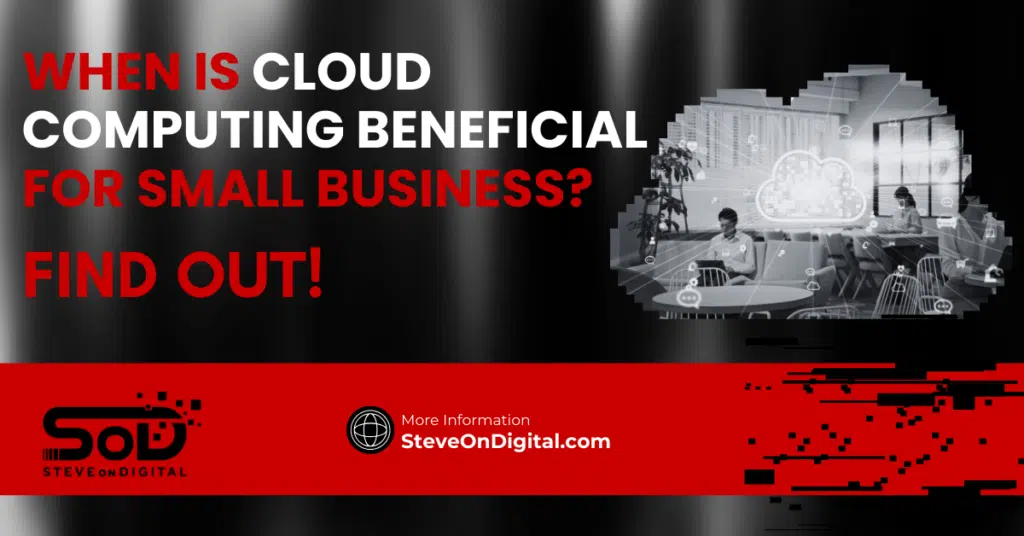
Cloud computing is beneficial for small businesses when they need to reduce IT costs, improve data accessibility, and enhance security. By adopting cloud computing services, small businesses can avoid the high upfront costs of physical infrastructure and instead pay only for the resources they use. This scalability allows businesses to grow without significant investment in hardware. As a small business owner, I’ve seen how cloud computing can transform operations. It provides the flexibility to work from anywhere, ensures data is backed up securely, and enables collaboration among team members, regardless of their location. Embracing cloud technology can significantly streamline business processes and drive growth. I’m Steve, a digital transformation expert with a strong background in electrical engineering, an MBA, and a master’s in Project Management. I excel at helping SMEs navigate the digital landscape with practical insights. Let’s begin! Understanding Cloud Computing What Is Cloud Computing? Cloud computing refers to the delivery of various services over the internet, including storage, computing power, and applications, without the need for local infrastructure or hardware. This technology allows businesses to access data and applications from anywhere with an internet connection. Types of Cloud Computing Services Type of Cloud Description Benefits Public Cloud Services delivered over the public internet, shared among multiple organizations Cost-effective, scalable, easy to use Private Cloud Services dedicated to a single organization Greater control, enhanced security Hybrid Cloud Combination of public and private clouds, data and applications can be shared Flexible, best of both worlds Key Cloud Providers Several major players dominate the cloud market, including Amazon Web Services (AWS), Microsoft Azure, and Google Cloud. These providers offer a range of services and solutions tailored to various business needs. Benefits of Cloud Computing for Small Businesses Cost Savings One of the primary benefits of cloud computing is cost savings. By moving to the cloud, small businesses can significantly reduce their IT expenses. Traditional on-premises systems require substantial investments in hardware and maintenance. In contrast, cloud services operate on a pay-as-you-go model, allowing businesses to scale their resources based on demand. For instance, small businesses that adopted cloud computing reported a 21% increase in profits and 26% faster growth compared to those that didn’t (CloudZero) (Flexera). Scalability and Flexibility Cloud computing offers unparalleled scalability and flexibility. Businesses can quickly scale their resources up or down based on their needs without worrying about hardware constraints. This flexibility is particularly beneficial for small businesses with fluctuating demands. Accessibility and Remote Work With cloud computing, data and applications are accessible from anywhere with an internet connection. This capability has become crucial in today’s remote work environment. Employees can collaborate seamlessly, access necessary tools, and maintain productivity, regardless of their location. Enhanced Collaboration Cloud-based tools facilitate better collaboration among team members. Applications like Google Workspace and Microsoft 365 allow multiple users to work on documents simultaneously, share updates in real-time, and streamline communication. Data Security and Backup Data security is a top priority for small businesses. Cloud service providers offer advanced security measures, including data encryption and multi-factor authentication, to protect sensitive information. Additionally, cloud backup services ensure that data is regularly backed up and can be restored in case of a disaster, reducing the risk of catastrophic data loss (Spacelift) (Parachute). Benefit Description Cost Savings Reduce IT expenses, pay-as-you-go model Scalability Scale resources based on demand Accessibility Access data and applications from anywhere Enhanced Security Advanced security measures like encryption and multi-factor authentication Improved Collaboration Real-time collaboration tools Key Cloud Services for Small Businesses Cloud Storage Services Cloud storage services offer a host of benefits for small businesses. They provide scalable storage solutions that grow with your business, eliminating the need for physical storage space. This scalability means you only pay for the storage you need, reducing costs. Additionally, cloud storage enhances accessibility, allowing you to access your files from any device with an internet connection. This flexibility is especially beneficial for remote work environments. Moreover, cloud storage services typically include data encryption and other security measures to protect your sensitive information from unauthorized access. Cloud Backup Services Cloud backup services are crucial for small businesses to safeguard against data loss. Unlike traditional backup methods, cloud backups are automated and continuous, ensuring that your data is always up-to-date. In the event of hardware failure, cyberattacks, or natural disasters, having a cloud backup means you can quickly restore your data with minimal downtime. This not only protects against catastrophic data loss but also enhances your business continuity plans. According to a study, businesses that adopt cloud backup solutions can recover from data loss incidents in a fraction of the time compared to those relying on physical backups (CloudZero) (Parachute). Cloud-Based Software Applications Cloud-based software applications are diverse and cater to various business needs. For instance, customer relationship management (CRM) systems like Salesforce and HubSpot help manage customer interactions and data efficiently. Project management tools such as Asana and Trello allow teams to collaborate on projects, track progress, and meet deadlines. Accounting and finance software like QuickBooks Online and Xero simplify financial management by automating invoicing, payroll, and expense tracking. These applications are accessible from any device, making them ideal for businesses with remote teams or multiple office locations. Cloud Computing for Specific Business Processes Customer Relationship Management (CRM) CRM systems hosted in the cloud offer significant advantages for small businesses. They centralize customer data, making it easier to track interactions and manage relationships. Cloud-based CRMs provide real-time updates, ensuring that your sales and customer service teams have the latest information at their fingertips. This leads to improved customer service and more effective sales strategies. Additionally, cloud CRMs often come with built-in analytics tools, helping you gain insights into customer behavior and preferences (Spacelift). Project Management Cloud-based project management tools streamline business operations by providing a unified platform for team collaboration. Tools like Asana, Trello, and Monday.com allow team members to create tasks, set deadlines, and share files, all in one place. This enhances transparency and accountability within the team. The ability to access these

